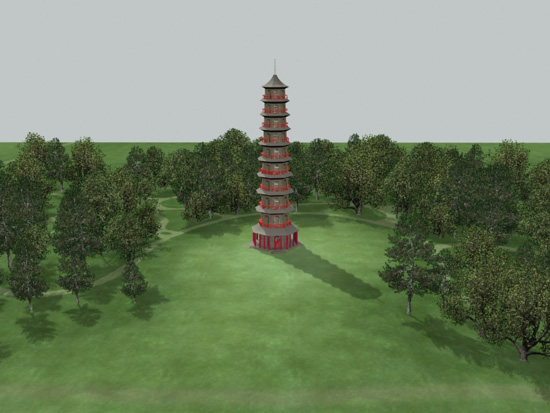|
3DVisA Resources 3DVisA Index of 3D Projects: Historic Gardens
How Kew Grew
A 3D exploration of Kew's past, from Roman landscape to the present day, produced by the King's Visualization Lab
in the Centre for Computing in the Humanities, King's College, London, for the Kew Gardens’ Heritage Festival, How Kew Grew, held from 27 May to 24 September 2006.

Fig. 1. How Kew Grew. Digital reconstruction of the Pagoda, 1762. © King's Visualization Lab. Reproduced with kind permission.
The Royal Botanic Gardens at Kew, Kew, Richmond, UK, is a UNESCO World Heritage Site. The gardens were founded in 1759 by Princess Augusta, widow of the Prince of Wales,
Frederick. The botanic garden of about 3.5 hectares was laid out by Augusta’s chief gardener, William Aiton and her botanical adviser, Lord Bute.
The pavilions, including the Orangery, Pagoda and Ruined Arch were designed by Sir William Chambers (1723-1769), the architect of the Somerset House in London’s Strand.
Queen Caroline continued the work on the gardens and plant collections. She appointed Charles Bridgemann as the Royal Gardener and commissioned the architect
William Kent to design the Hermitage and Merlin’s cave.
The animation displayed during the Kew Heritage Festival 2006 in the Princess of Wales Conservatory showed the natural landscape, garden features and buildings, and
illustrated the development of Kew from Roman times to the present day.
Digital visualisation features a number of existing buildings, including the Kew Palace (1631), Ruined Arch (1759) and Pagoda (1762), as well as pavillions which have not
survived, such as the Hermitage and Merlin’s cave. Various routes and vistas link key architectural points. Large swaith of landscape planted with trees and embellished with water features have been
visualise showing how Kew evolved over the years. Reconstruction was based on archival material - drawings, maps and historic photographs - as well as new photographs taken for this project.
The producer of How Kew Grew, Peter James commented: 'The presentation hopefully will work equally for anyone who has never been to Kew before, but will also
uncover some 'secrets' for visitors more familiar with the gardens who may not be aware of some of the significance of the buildings and landscapes through which
they walk regularly. For the first time, as much of the information that exists on drawings, paintings, old maps and descriptions, has been drawn together
and displayed for the enjoyment of visitors.' (Source: King’s College Press Release, 25 May 2006).
Project dates: 2005-2006
Resource status: The animation How Kew Grew was on display in the Princess of Wales Conservatory at Kew in the summer of 2006. A DVD is available from Kew shops.
Contributors: Programming and modelling by Dew Barker, Martin Bazely, Mike Macgruder, King's Visualization Lab, Centre for Computing in the Humanities, King’s College
London; King's Visualization Lab; Christina Hanson, John Londsdale, Jill Preston; Department of Educational Services of Kew Gardens, Kew, Richmond, UK; Funded by the Trustees of the Royal Botanic Gardens Kew. Directed by
Lord Attenborough, produced by Peter James, narrated by Phill Reynolds.
Sources and further details:
How Kew Grew at the KVL website
Reading the Royal Landscape, (2006) Press Release, Royal Botanic Gardens, Kew.
How Kew Grew, (2006), Press Release PR69/06, King's College, London, 25 May.
Record compiled by Anna Bentkowska-Kafel. Last updated: 11 September 2006.
3DVisA gratefully acknowledges the help of King's Visualization Lab with preparation of this record.
© King's Visualization Lab, Kew Gardens and 3DVisA, 2006.
Back to the list of 3D projects>
|
